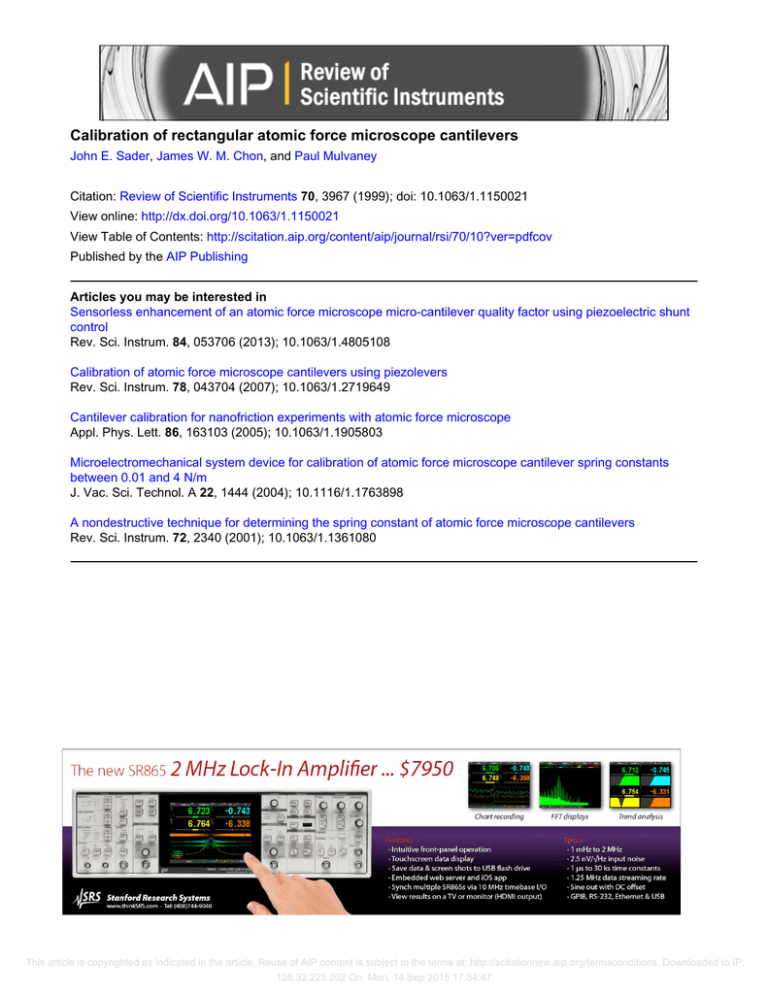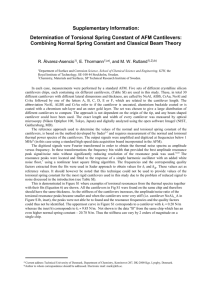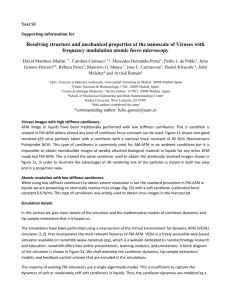Calibration of rectangular atomic force microscope cantilevers
advertisement

Calibration of rectangular atomic force microscope cantilevers John E. Sader, James W. M. Chon, and Paul Mulvaney Citation: Review of Scientific Instruments 70, 3967 (1999); doi: 10.1063/1.1150021 View online: http://dx.doi.org/10.1063/1.1150021 View Table of Contents: http://scitation.aip.org/content/aip/journal/rsi/70/10?ver=pdfcov Published by the AIP Publishing Articles you may be interested in Sensorless enhancement of an atomic force microscope micro-cantilever quality factor using piezoelectric shunt control Rev. Sci. Instrum. 84, 053706 (2013); 10.1063/1.4805108 Calibration of atomic force microscope cantilevers using piezolevers Rev. Sci. Instrum. 78, 043704 (2007); 10.1063/1.2719649 Cantilever calibration for nanofriction experiments with atomic force microscope Appl. Phys. Lett. 86, 163103 (2005); 10.1063/1.1905803 Microelectromechanical system device for calibration of atomic force microscope cantilever spring constants between 0.01 and 4 N/m J. Vac. Sci. Technol. A 22, 1444 (2004); 10.1116/1.1763898 A nondestructive technique for determining the spring constant of atomic force microscope cantilevers Rev. Sci. Instrum. 72, 2340 (2001); 10.1063/1.1361080 This article is copyrighted as indicated in the article. Reuse of AIP content is subject to the terms at: http://scitationnew.aip.org/termsconditions. Downloaded to IP: 128.32.225.202 On: Mon, 14 Sep 2015 17:54:47 REVIEW OF SCIENTIFIC INSTRUMENTS VOLUME 70, NUMBER 10 OCTOBER 1999 Calibration of rectangular atomic force microscope cantilevers John E. Sadera) Department of Mathematics and Statistics, University of Melbourne, Parkville, 3052 Victoria, Australia James W. M. Chon and Paul Mulvaney School of Chemistry, University of Melbourne, Parkville, 3052 Victoria, Australia 共Received 20 April 1999; accepted for publication 1 July 1999兲 A method to determine the spring constant of a rectangular atomic force microscope cantilever is proposed that relies solely on the measurement of the resonant frequency and quality factor of the cantilever in fluid 共typically air兲, and knowledge of its plan view dimensions. This method gives very good accuracy and improves upon the previous formulation by Sader et al. 关Rev. Sci. Instrum. 66, 3789 共1995兲兴 which, unlike the present method, requires knowledge of both the cantilever density and thickness. © 1999 American Institute of Physics. 关S0034-6748共99兲04210-0兴 I. INTRODUCTION The ability to experimentally determine the spring constants of atomic force microscope 共AFM兲 cantilevers is of fundamental importance in many applications of the AFM. To date many methods have been devised for this purpose. These include methods that monitor the static deflection of the cantilevers1,2 and those that utilize the cantilevers’ dynamic deflection properties.3–5 Recently, Sader et al.5 proposed a method whereby the spring constant of an AFM cantilever is determined from its unloaded resonant frequency. The mass of the cantilever is also required and this is typically obtained from the density, thickness, and plan view dimensions of the cantilever. In particular, for the case of a rectangular cantilever, the spring constant is given by 2 , k⫽M e c bhL vac 共1兲 where vac is the fundamental radial resonant frequency of the cantilever in vacuum, h, b, and L are the thickness, width, and length of the cantilever, respectively, c is the density of the cantilever, and M e is the normalized effective mass which takes the value M e ⫽0.2427 for L/b⬎5.5 Although simple in appearance, application of Eq. 共1兲 has been limited for several practical reasons that we shall now discuss. In contrast to the plan view dimensions of the cantilever that are easily measured using optical techniques, the thickness measurement typically requires the use of electron microscopy which can be time consuming and cannot be routinely carried out on every cantilever. Furthermore, determination of the density or mass of the cantilever can pose an even greater difficulty. Typically, the reflectivity of AFM cantilevers is increased by the deposition of thin gold films onto the substrate Si or Si3N4. This also necessitates the deposition of a thin sputter-coated chromium layer to improve adhesion of the gold layer. For most commercial cantilevers the thickness of these individual layers is unknown, so that the average density of the cantilevers, and hence their mass, remain completely undetermined.5 Also, measurements of the frequency response of AFM cantilevers are commonly performed in an a兲 Electronic mail: j.sader@ms.unimelb.edu.au air or liquid medium. It is well known that the surrounding medium can significantly reduce the resonant frequency from its value in vacuum.5 Hence, if not accounted for, this effect can introduce an unnecessary and significant error into the calibration procedure.5 In an effort to understand the role of the surrounding fluid medium on cantilever dynamics, we recently examined the effect of immersing a rectangular AFM cantilever in a viscous fluid.6,7 There it was found that the shift in resonant frequency of the cantilever from vacuum to fluid 共gas or liquid兲 was strongly dependent on both the density and viscosity of the fluid and it could be accurately modeled. We now show that these same results can be used to formulate a simple, practical, and accurate method for the determination of the spring constants of rectangular AFM cantilevers. The present method of calibration eliminates the requirement for a priori knowledge of the density and thickness, and automatically accounts for the effects of the surrounding fluid, thus overcoming the problems mentioned above. The spring constant of a rectangular cantilever is then determined from its plan view dimensions, and the measurement of its resonant frequency and quality factor in fluid 共typically air兲. All these quantities are readily accessible and facilitate fast and accurate determination of the spring constant by the present method. The following formulation pertains to a rectangular cantilever whose length L greatly exceeds its width b which in turn greatly exceeds its thickness h, which is the case commonly encountered in practice. We shall examine the practical limitations of this assumption and assess the accuracy and validity of the present method by giving a detailed comparison with experimental measurements. II. THEORY To begin we note that the shift in the resonant frequency from vacuum to fluid is primarily due to inertial effects in the fluid.6,7 It then follows that if the quality factor Q f of the fundamental mode of the cantilever in fluid greatly exceeds 1 共which is typically satisfied when the cantilever is placed in air6–8兲, the vacuum resonant frequency vac is related to the resonant frequency in fluid f by6 0034-6748/99/70(10)/3967/3/$15.00 3967 © 1999 American Institute of Physics This article is copyrighted as indicated in the article. Reuse of AIP content is subject to the terms at: http://scitationnew.aip.org/termsconditions. Downloaded to IP: 128.32.225.202 On: Mon, 14 Sep 2015 17:54:47 3968 Rev. Sci. Instrum., Vol. 70, No. 10, October 1999 Sader, Chon, and Mulvaney TABLE I. Comparison of spring constants for calibrated cantilevers 共Ref. 10兲 determined by the manufacturer k man and by the present method k new . f f and Q f are the resonant frequency and quality factor in air, respectively. The results for 397 and 197 m cantilevers were obtained from their thermal noise spectra, whereas the results for the 97 m cantilever were obtained by driving the cantilever. Dimensions of the cantilevers: b⫽29 m and h⫽2 m. Properties of air: f ⫽1.18 kg m⫺3 and ⫽1.86⫻10⫺5 kg m⫺1 s⫺1. FIG. 1. Plot of the real and imaginary components of the hydrodynamic function ⌫共兲 as a function of the Reynolds number Re⫽ f b 2 /(4 ). The real component ⌫ r is shown by the solid line; the imaginary component ⌫ i is shown by the dashed line. 冉 vac⫽ f 1⫹ f b 4 ch ⌫ r共 f 兲 冊 1/2 , 共2兲 whereas the areal mass density c h is given by6 c h⫽ f b 4 关 Q f ⌫ i 共 f 兲 ⫺⌫ r 共 f 兲兴 , 共3兲 where f is the density of the fluid, and ⌫ r and ⌫ i are, respectively, the real and imaginary components of the hydrodynamic function ⌫, which is plotted in Fig. 1. The reader is referred to Eq. 共20兲 of Ref. 6 for an analytical expression for ⌫. We note that ⌫共兲 only depends on the Reynolds number Re⫽ f b 2 /(4 ), where is the viscosity of the surrounding fluid, and is independent of the cantilever thickness and density. Substituting Eqs. 共2兲 and 共3兲 into Eq. 共1兲 we obtain the required result k⫽0.1906 f b 2 LQ f ⌫ i 共 f 兲 2f . 共4兲 Equation 共4兲 relates the spring constant k directly to the plan view dimensions of the cantilever, the fundamental mode resonant frequency f , and the quality factor Q f in fluid. This expression is valid provided the quality factor Q f Ⰷ1, which is typically satisfied when the cantilevers are placed in air. We also note that if the areal mass density and vacuum frequency of the cantilever are required, then these can be easily obtained from Eqs. 共2兲 and 共3兲. III. EXPERIMENTAL RESULTS We now assess the accuracy of the present method by presenting a detailed comparison with experimental measurements. Two different sets of cantilevers were chosen for this comparison. The first set, henceforth referred to as calibrated cantilevers, were procured from Park Scientific Instruments9 and have a highly uniform rectangular geometry, with accurately controlled material properties and dimensions.10 Consequently, the spring constants of these cantilevers are specified to a high tolerance by the manufacturer.9,10 The second set of cantilevers were obtained from Digital Instruments,11 and are identical to the cantilevers used by Walters et al.8 These latter cantilevers are gold coated and have a nonideal geometry 共i.e., the end is cleaved L 共m兲 ff 共kHz兲 Qf k man (N m⫺1) k new (N m⫺1) 397 197 97 17.36 69.87 278.7 55.5 136 309 0.157 1.3 10.4 0.157 1.30 10.7 and a tip is added; see Ref. 8 for details兲. The spring constants of these cantilevers were measured using the method of Cleveland et al.4 These results served as the benchmark for comparison with the present method. All measurements made using the present method were performed in air, thus satisfying the criterion that Q f Ⰷ1. To obtain the quality factor Q f and resonant frequency f , as is required in the present method, we measured the thermal noise spectra of the cantilevers using a National Instruments data acquisition 共DAQ兲 card,12 carrying out a digital fast Fourier transform of the signal using LabVIEW software.13 The fundamental mode resonance peaks of the measured spectra were then fitted to the response of a simple harmonic oscillator,6,14 using a nonlinear least squares fitting procedure.15 A white noise floor was included in the fitting procedure14 to ensure accurate fits to the noise spectra. In some cases, a large spring constant precluded the measurement of the thermal noise spectrum, due to low cantilever vibration amplitude. For these situations, the frequency response of the cantilever was measured by driving the cantilever at a range of frequencies in the neighborhood of its fundamental mode resonance peak.16 We emphasize that this approach gives the same results for Q f and f as that obtained from the thermal noise spectrum, provided the drive amplitude is not large enough to invoke nonlinearities. These two approaches allowed easy and accurate determination of the quality factor 共⫾1%兲 and resonant frequency 共⫾0.1%兲. The plan view dimensions of the cantilevers were measured using an optical microscope. In Table I, we present results for the calibrated cantilevers.10 For each cantilever, the method by which its resonant frequency and quality factor was obtained is indicated. Note the very good accuracy achieved by the present method for all cantilevers, whose aspect ratios range from L/b⫽3.3– 13.7. In Table II, we present results for the second set of cantilevers which are gold coated and have a nonideal geometry.8 Again note the good accuracy obtained by the present method in comparison to the method of Cleveland et al.4 for all cantilevers, which range in aspect ratio from L/b⫽3.9– 10. For these cantilevers, the thermal noise spectrum was used to evaluate Q f and f in all cases. From these results it is clear that the present method is capable of accurate determination of the spring constants of rectangular AFM cantilevers, whose aspect ratios L/b exceed 3,17 which is the case commonly encountered in practice. The present method overcomes the shortcomings of the method proposed in Ref. 5 by eliminating the requirement for knowledge of This article is copyrighted as indicated in the article. Reuse of AIP content is subject to the terms at: http://scitationnew.aip.org/termsconditions. Downloaded to IP: 128.32.225.202 On: Mon, 14 Sep 2015 17:54:47 Rev. Sci. Instrum., Vol. 70, No. 10, October 1999 Calibration of cantilevers TABLE II. Comparison of spring constants for gold coated cantilevers 共Ref. 8兲 determined by the method of Cleveland et al. 共Ref. 4兲 k clv and by the present method k new . f f and Q f are the resonant frequency and quality factor in air, respectively. Dimensions of the cantilevers: b⫽20 m and h ⫽0.44 m. Properties of air: f ⫽1.18 kg m⫺3 and ⫽1.86 ⫻10⫺5 kg m⫺1 s⫺1. L 共m兲 ff 共kHz兲 Qf k clv (N m⫺1) k new (N m⫺1) 203 160 128 105 77 10.31 15.61 24.03 36.85 64.26 17.6 22.7 30.9 41.7 60.3 0.010 0.019 0.038 0.064 0.15 0.010 0.018 0.034 0.067 0.15 Finally, we note that the present method can also be used indirectly to calibrate cantilevers of different geometries, as we shall now discuss. If all cantilever chips manufactured had a single rectangular cantilever attached, as is the case in some chips currently produced,9 then the calibration of all cantilevers could be made very simple and routine using the present method. This would utilize the property that the thickness and material properties of all cantilevers over a single chip are typically constant. The procedure would then involve calibration of the rectangular cantilever, from which the product Eh 3 , where E is Young’s modulus, could be easily evaluated using b . The authors would like to express their gratitude to Dr. J. P. Cleveland of Digital Instruments, USA, and Dr. T. Schaeffer of the Department of Physics, University of California, Santa Barbara, for many interesting and stimulating discussions. This research was carried out with the support of the Advanced Minerals Products Center, an ARC Special Research Center and was also supported in part by ARC Grant No. S69812864. T. J. Senden and W. A. Ducker, Langmuir 10, 1003 共1994兲. Y. Q. Li, N. J. Tao, J. Pan, A. A. Garcia, and S. M. Lindsay, Langmuir 9, 637 共1993兲. 3 J. L. Hutter and J. Bechhoefer, Rev. Sci. Instrum. 64, 1868 共1993兲. 4 J. P. Cleveland, S. Manne, D. Bocek, and P. K. Hansma, Rev. Sci. Instrum. 64, 403 共1993兲. 5 J. E. Sader, I. Larson, P. Mulvaney, and L. R. White, Rev. Sci. Instrum. 66, 3789 共1995兲. 6 J. E. Sader, J. Appl. Phys. 84, 64 共1998兲. 7 J. W. M. Chon, P. Mulvaney, and J. E. Sader, J. Appl. Phys. 共submitted兲. 8 D. A. Walters, J. P. Cleveland, N. H. Thomson, P. K. Hansma, M. A. Wendman, G. Gurley, and V. Elings, Rev. Sci. Instrum. 67, 3583 共1996兲. 9 Park Scientific Instruments, 1171 Borregas Ave., Sunnyvale, CA 940891304. 10 M. Tortonese and M. Kirk, Proc. SPIE 3009, 53 共1997兲. 11 Digital Instruments, 112 Robin Hill Road, Santa Barbara, CA 93117. 12 AT-MIO-16E-1 board, available from National Instruments, 6504 Bridge Point Parkway, Austin, TX 78730-5039. 13 LabVIEW is a registered trademark of, and is available from, National Instruments 共see Ref. 12兲. 14 The resonant frequency f and quality factor Q f were obtained by fitting the power spectra to the functional P( )⫽A white⫹B 4f / 关 ( 2 ⫺ 2f ) 2 ⫹ 2 2f /Q 2f 兴 . The fitting parameters are A white , B, f , and Q f . 15 Mathematica is a registered trademark of, and is available from, Wolfram Research, Inc., 100 Trade Center Drive, Champaign, IL 61820-7237. 16 The cantilevers were vibrating at their base using the Tapping Mode cantilever tune software in the Nanoscope III atomic force microscope 共Digital Instruments, USA兲. 17 To establish the ultimate lower limit for L/b, for which the method is applicable, measurements need to be performed on cantilevers with aspect ratios smaller than those used in this study. 18 J. E. Sader and L. White, J. Appl. Phys. 74, 1 共1993兲. 19 J. E. Sader, Rev. Sci. Instrum. 66, 4583 共1995兲. 20 J. M. Neumeister and W. A. Ducker, Rev. Sci. Instrum. 65, 2527 共1994兲. 21 S. Timoshenko and S. Woinowsky-Krieger, Theory of Plates and Shells 共McGraw–Hill, New York, 1959兲. 2 IV. NON-RECTANGULAR CANTILEVERS 4L 3 ACKNOWLEDGMENTS 1 the cantilever’s thickness, density, and resonant frequency in vacuum, parameters that in practice can be difficult to measure. Eh 3 ⫽k 3969 共5兲 Subsequently, theoretical results for the spring constants, such as those found in Refs. 18–21, could then be used to calibrate cantilevers of other geometries. This would require only the plan view dimensions of the cantilevers, which are easily measured. This article is copyrighted as indicated in the article. Reuse of AIP content is subject to the terms at: http://scitationnew.aip.org/termsconditions. Downloaded to IP: 128.32.225.202 On: Mon, 14 Sep 2015 17:54:47



